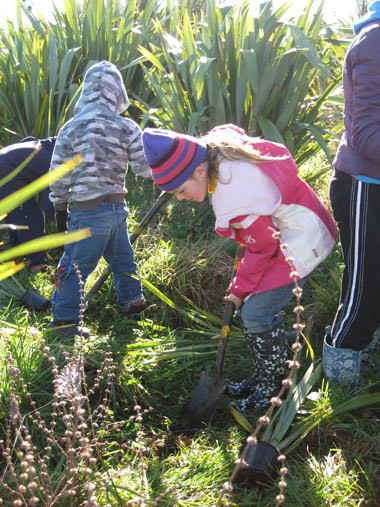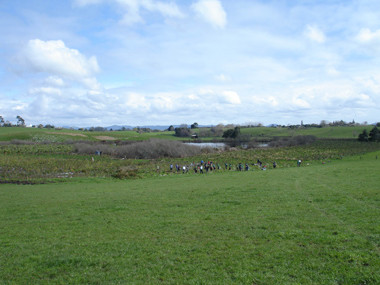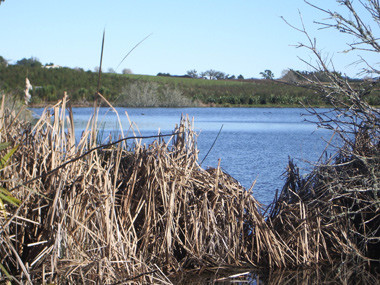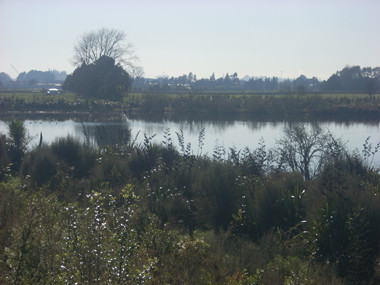Waiwhakareke Natural Heritage Park is a 60ha park located on the north west outskirts of Hamilton, bounded by Baverstock, Rotokauri and Brymer Roads. The vision for the Park is to create a self-sustaining habitat sanctuary that represents the original ecosystem diversity of the Hamilton Basin. This involves a reconstruction from farmland of traditional native lowland and wetland ecosystems once widespread, but now rare in the Waikato Region. The Park includes a peat lake (Waiwhakareke) that, before recent control work, was surrounded by introduced willow trees. Restoration plantings on the former pasture focussed initially on the lake margin and have progressively expanded onto the adjacent hill slopes and more distant ridge crests.
 The Waikato in general and Hamilton in particular has very little left of the vegetation that existed before human settlement. This park will bring back examples of all the main ecosystem types and make them accessible to the people of Hamilton for recreation, education and relaxation. It will also be a notable tourist attraction.
The Waikato in general and Hamilton in particular has very little left of the vegetation that existed before human settlement. This park will bring back examples of all the main ecosystem types and make them accessible to the people of Hamilton for recreation, education and relaxation. It will also be a notable tourist attraction.
Recently, tui have been sighted in significant numbers in Hamilton, having been absent for many years. The growth of Waiwhakareke Natural Heritage Park will make the city even more attractive for tui in the future.
The concept of Waiwhakareke Natural Heritage Park began as an idea of a ‘living museum’ that would represent the ecosystem diversity of the Hamilton Basin. In 2003 Council notified its intention to devote 50ha of land to the development of Waiwhakareke Natural Heritage Park. In 2004 the first plantings took place and the project was officially launched by the Hon. Chris Carter, Minister of Conservation at the time. Since then community and corporate volunteers and council workers have carried out planting in the park each year.
In 2005 a draft management plan for the park was produced and a variety of research began around different establishment methods and different initial plant compositions. The park will comprise five main ecosystem types:
Kauri, tanekaha, rewarewa conifer-broadleaved forest
These are canopy species once prominent on the ridge crests around Hamilton. This ecosystem will be replanted on the higher points at the west of the park. See the Kauri-podocarp-broadleaved section of this website for more information.
Tawa, rimu broadleaved-podocarp forest
This type of ecosystem was once the most prevalent forest type in the Waikato and will be replanted on the hill slopes of the park. See the podocarp-broadleaved forest section of this website.
Kahikatea, pukatea semi-swamp forest
Once a dominant vegetation type of the Hamilton Basin, the semi-swamp ecosystem will be created on the park’s lower, flatter areas. See the podocarp-broadleaved forest section of this website.
Peat lake margin and swamp wetland
 Pre-European settlement wetlands covered 50,000ha of the Hamilton Basin of which only 1% now remains. An example of the Waikato’s most prevalent wetland type, Sporodanthus bog, is being recreated at the park. This bog is being created through the formation of a peat dome at the lake’s edge. A peat dome is a type of wetland that rises higher than the general water level. It develops from layers of vegetation that grow year-by-year without decomposing. The two native plants that contribute to the peat dome - Sporadanthus ferrugineus (Cane Rush) and Empodisma minus (Wire Rush)- are threatened because so much of New Zealand’s peaty wetland has been drained and destroyed, S. ferrugineus and E. minus are threatened plants. To create the peat dome for Waiwhakareke, peat was brought by truck from Torehape on the Hauraki Plains and deposited by the eastern border of the lake. This area will need weed control until the S. ferrugineus and E. minus grow to cover the ground and spread their seed.
Pre-European settlement wetlands covered 50,000ha of the Hamilton Basin of which only 1% now remains. An example of the Waikato’s most prevalent wetland type, Sporodanthus bog, is being recreated at the park. This bog is being created through the formation of a peat dome at the lake’s edge. A peat dome is a type of wetland that rises higher than the general water level. It develops from layers of vegetation that grow year-by-year without decomposing. The two native plants that contribute to the peat dome - Sporadanthus ferrugineus (Cane Rush) and Empodisma minus (Wire Rush)- are threatened because so much of New Zealand’s peaty wetland has been drained and destroyed, S. ferrugineus and E. minus are threatened plants. To create the peat dome for Waiwhakareke, peat was brought by truck from Torehape on the Hauraki Plains and deposited by the eastern border of the lake. This area will need weed control until the S. ferrugineus and E. minus grow to cover the ground and spread their seed.
Peat lake/aquatic ecosystem
Lake Waiwhakareke will be managed to recreate and maintain the original aquatic ecosystem of a Waikato peat lake, peat stained and with a low nutrient status.
As with all restoration projects it will be many years before a self sustaining habitat will be developed. Professor Bruce Clarkson of the Centre for Biology and Ecology Research at the University of Waikato believes that the project’s long time horizon will require an intergenerational approach, acknowledging that the work will need to be continued by those who follow.
Establishment into pasture also presents some unique problems and research opportunities. With such a large project it is desirable to minimise the number of repeat visits for maintenance and for establishment of the second generation of species. Accordingly a number of different approaches to initial plant mix and establishment are being trialled. How practical is it to plant shade tolerant canopy species into bare pasture? Will they survive initial exposure and flourish once the initial colonisers are established? The performance of different approaches will be monitored over time and will yield valuable information for this project and others that will follow.
The park is over the road from Hamilton Zoo, which will play an increasing role as the park develops through the re-introduction of suitable bird species and invertebrates, helping to re-build the complexity of a natural eco-system.
The Park will eventually meet the various needs of students, residents and visitors and will have four main roles in conservation, education, passive recreation and scientific research. Proposed developments on site in the future include a visitor centre/café link and conservation education centre with the Hamilton Zoo, construction of a pest proof fence as well as a walkways within the park and a cycleway around the perimeter with both linking to networks in the surrounding residential areas.
 Waiwhakareke Natural Heritage Park is a joint partnership between Hamilton City Council, the University of Waikato (particularly the Centre for Biodiversity and Ecology Research), Waikato Institute of Technology (Wintec), Tui2000 and Nga Mana Toopu O Kirikiriroa. Through various groups and forums these partners work together to decide the management and development of the Park. Operational funding comes from Hamilton City Council and in kind from the partners and volunteers. Capital development is funded in part by Hamilton City Council and in part by grants from various sources.
Waiwhakareke Natural Heritage Park is a joint partnership between Hamilton City Council, the University of Waikato (particularly the Centre for Biodiversity and Ecology Research), Waikato Institute of Technology (Wintec), Tui2000 and Nga Mana Toopu O Kirikiriroa. Through various groups and forums these partners work together to decide the management and development of the Park. Operational funding comes from Hamilton City Council and in kind from the partners and volunteers. Capital development is funded in part by Hamilton City Council and in part by grants from various sources.
Volunteers are relied upon heavily for the continued growth of the Park, with community planting days held regularly. The partners urge the public to keep an eye out for advertisements promoting these planting days and any other ways they can help to support what will eventually be a community park of great significance.
 In May 2009 the Waikato Biodiversity Forum held a meeting regarding the Waiwhakareke Natural Heritage Park. This pulled together biodiversity and restoration specialists, interest groups and members of the public for an interactive, informative and collaborative sharing of ideas based around the core theme of Waiwhakareke Natural Heritage Park. This event promoted Waiwhakareke on a regional scale and helped to generate support and acknowledgement from the wider Waikato community.
In May 2009 the Waikato Biodiversity Forum held a meeting regarding the Waiwhakareke Natural Heritage Park. This pulled together biodiversity and restoration specialists, interest groups and members of the public for an interactive, informative and collaborative sharing of ideas based around the core theme of Waiwhakareke Natural Heritage Park. This event promoted Waiwhakareke on a regional scale and helped to generate support and acknowledgement from the wider Waikato community.
There is also a recently formed group ‘Friends of Waiwhakareke’ which is made up of volunteers of all ages who gather at the park on the last Saturday of every month (excluding December) to contribute to maintenance activities such as weeding and planting. To be a part of this group people can check the website of Waiwhakareke Natural Heritage Park or contact Catherine Smith at [Enable JavaScript to view protected content].
